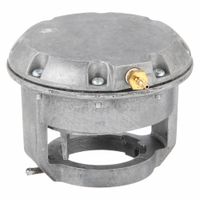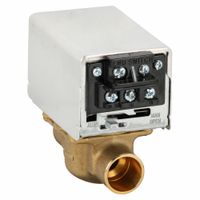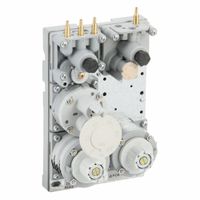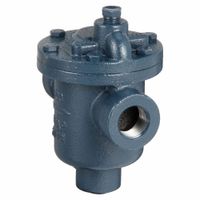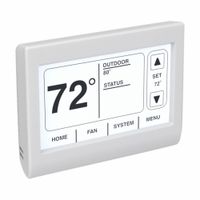Call +(254) 703 030 000 / 751 483 999 / 721 704 777
- Home
- Hvac And Refrigeration
- Hvac Controls And Thermostats
.....Read More
Frequently Asked Questions
What is the best thermostat for my HVAC system?
Choosing the "best" thermostat for an HVAC system depends largely on individual needs and preferences. Programmable thermostats are a popular choice, allowing users to set schedules for heating and cooling, which can lead to energy savings. Smart thermostats offer even more advanced features, such as remote control via a smartphone app, learning capabilities that adapt to your habits, and integration with smart home ecosystems like Google Home or Amazon Alexa. Some smart thermostats also provide detailed energy usage reports. For those seeking maximum energy efficiency, models with zoning capabilities allow different areas of a home to be heated or cooled independently.
Key factors to consider include the type of HVAC system you have (e.g., conventional, heat pump, multi-stage), your budget, and desired features. Compatibility is crucial; ensure the thermostat you select works with your existing wiring and HVAC unit. Ease of use, display readability, and the availability of professional installation (if needed) are also important considerations. Ultimately, the ideal thermostat strikes a balance between functionality, energy efficiency, and user-friendliness for your specific living situation.
How do I troubleshoot a malfunctioning thermostat?
Please provide a specific topic for me to elaborate on.
How do I program my thermostat for energy efficiency?
To program your thermostat for energy efficiency, start by understanding your daily routine. Most programmable thermostats allow you to set different temperatures for various times of the day, such as when you're home, away, or sleeping. A common strategy is to set a lower temperature when you're out of the house or asleep, and a more comfortable temperature during your active hours.
For heating, aim to set the temperature lower by 7-10 degrees Fahrenheit (4-6 degrees Celsius) for at least eight hours a day, for instance, overnight or when you're at work. For cooling, raise the temperature by a similar margin during these periods. This setback can significantly reduce energy consumption without sacrificing comfort when you need it.
Consider using a "smart" thermostat if available, as these devices can learn your preferences and even adjust based on external factors like weather forecasts or your home's insulation. Some smart thermostats also offer remote control via smartphone apps, allowing you to fine-tune settings from anywhere. Always ensure your thermostat is properly calibrated and that your HVAC system is regularly maintained for optimal performance and energy savings.
What are the benefits of smart thermostats?
Smart thermostats offer several benefits that can enhance comfort, convenience, and energy efficiency in your home. They allow you to control your home's temperature remotely via a smartphone app, providing flexibility whether you're at work, on vacation, or just in another room. Many smart thermostats learn your preferences and daily routines, automatically adjusting the temperature to optimize comfort and save energy. They can also provide detailed energy usage reports, helping you identify areas where you can reduce consumption. Some models integrate with other smart home devices, allowing for a more unified and automated home environment. Features like geofencing can detect when you're away from home and adjust the temperature accordingly, further contributing to energy savings. By intelligently managing your heating and cooling, smart thermostats can significantly lower your energy bills while maintaining a comfortable living space.
How do I replace my old thermostat with a new one?
Replacing an old thermostat with a new one involves a few key steps to ensure proper function and safety. First, turn off the power to your HVAC system at the circuit breaker to avoid electrical shock. Next, carefully remove the old thermostat from the wall. This usually involves unscrewing it from the mounting plate or gently prying it off. Take a picture of the wiring before disconnecting any wires; this will serve as a helpful reference for connecting the new thermostat. Label each wire with masking tape, indicating which terminal it was connected to (e.g., R, G, Y, W, C).
Once the old thermostat is removed, you can begin installing the new one. Mount the new thermostat's backplate to the wall, ensuring it's level. Then, connect the wires to the corresponding terminals on the new thermostat, referring to the picture you took and the labels you made. If your new thermostat requires a C-wire for continuous power and your old setup didn't have one, you might need to install one or use an adapter kit if available. After all wires are securely connected, snap the new thermostat face onto the backplate. Finally, turn the power back on at the circuit breaker and test the new thermostat's heating and cooling functions to ensure it's working correctly. Consult your new thermostat's manual for specific instructions, as procedures can vary slightly between models.
How do HVAC sensors work?
HVAC sensors are crucial components that monitor and regulate various aspects of a heating, ventilation, and air conditioning system to maintain a comfortable indoor environment and optimize energy efficiency. These sensors detect changes in temperature, humidity, air quality, and pressure, sending data to the HVAC control system.
Temperature sensors, such as thermistors or thermocouples, measure air temperature at different points in the system (e.g., return air, supply air, outdoor air) to ensure the system heats or cools to the desired set point. Humidity sensors (hygrometers) detect moisture levels, helping to control indoor humidity and prevent issues like mold growth or excessive dryness.
Air quality sensors, including particulate matter (PM) sensors, volatile organic compound (VOC) sensors, and carbon dioxide (CO2) sensors, monitor the presence of pollutants and allergens, triggering ventilation or filtration systems as needed to improve indoor air quality. Pressure sensors measure air pressure in ducts or across filters, indicating airflow issues or when filters need replacement.
Once data is collected, the HVAC control system processes this information and makes adjustments to components like the fan speed, compressor operation, or damper positions. For instance, if a temperature sensor detects the room is too warm, the system will increase cooling. If a CO2 sensor detects high levels, it might increase outdoor air intake. This continuous monitoring and feedback loop allow HVAC systems to operate efficiently, provide optimal comfort, and maintain healthy indoor air.
What is the role of actuators in HVAC systems?
Actuators are crucial components in HVAC (Heating, Ventilation, and Air Conditioning) systems, responsible for converting an electrical or pneumatic signal into mechanical motion. Their primary role is to control the flow of air, water, or other fluids within the system to regulate temperature, humidity, and air quality.
In air-side applications, actuators are commonly used to operate dampers, which are movable plates that control the airflow in ducts. By opening or closing dampers, actuators can direct conditioned air to specific zones, mix fresh air with return air, or shut off airflow to unoccupied areas, optimizing energy efficiency.
In water-side applications, actuators are used to control valves in hydronic systems. These valves regulate the flow of hot or chilled water to coils, radiators, or other heat exchange components. For example, in a chilled water system, an actuator might open a valve to allow more cold water to flow through a cooling coil when a space needs to be cooled, or close it when the desired temperature is reached.
Actuators receive signals from thermostats, building management systems (BMS), or other controllers. Based on these signals, they precisely adjust the position of dampers or valves, ensuring that the HVAC system maintains the desired environmental conditions while minimizing energy consumption. Their accurate and responsive operation is vital for the overall efficiency, comfort, and performance of any modern HVAC system.
How do pneumatic controls differ from electronic controls in HVAC systems?
Pneumatic and electronic controls represent two distinct approaches to managing HVAC systems, each with unique operational principles and applications.
Pneumatic controls rely on compressed air to transmit signals and actuate devices. They consist of components like thermostats, sensors, and actuators connected by small tubing. A change in temperature, for instance, alters the air pressure in a thermostat, which then signals an actuator to open or close a damper or valve. These systems are known for their simplicity, robustness, and reliability, particularly in harsh environments where electronic components might be susceptible to damage from moisture or extreme temperatures. They are also intrinsically safe in hazardous locations because they don't use electricity. However, pneumatic systems can be less precise, slower to respond, and require ongoing maintenance of air compressors and tubing to prevent leaks and maintain proper pressure.
Electronic controls, in contrast, use electrical signals to operate HVAC components. These systems often involve digital sensors, microprocessors, and electronically controlled actuators. Temperature sensors convert thermal data into electrical signals, which are then processed by a controller that sends commands to fans, pumps, and valves. Electronic systems offer superior precision, faster response times, and greater flexibility due to their programmable nature. They can easily integrate with building management systems (BMS) for centralized control, data logging, and energy optimization. While generally more energy-efficient and capable of sophisticated control strategies, electronic systems can be more complex to install and troubleshoot, and are susceptible to electromagnetic interference or power fluctuations. The choice between pneumatic and electronic controls often depends on factors like budget, required control accuracy, environmental conditions, and integration needs within a building's overall automation strategy.
How do I maintain and clean my HVAC system components?
Maintaining and cleaning your HVAC system components is crucial for its efficiency, longevity, and the air quality in your home.
Here's how to do it: * **Air Filters:** This is the easiest and most frequent maintenance task. Check your air filters monthly and replace them every 1-3 months, or more often if you have pets or allergies. A dirty filter restricts airflow and makes your system work harder.
* **Outdoor Unit (Condenser):**
* **Clear Debris:** Regularly clear away leaves, grass clippings, dirt, and other debris from around the outdoor unit. Aim for at least two feet of clearance in all directions.
* **Clean Coils:** Annually, or when visibly dirty, clean the condenser coils. Turn off power to the unit first. You can use a soft brush or a garden hose with a gentle spray to remove dirt and grime from the fins. Be careful not to bend the delicate fins.
* **Straighten Fins:** If any fins are bent, gently straighten them with a fin comb (available at hardware stores) to improve airflow.
* **Indoor Unit (Evaporator Coil and Drain Pan):** This usually requires professional attention, but you can inspect it.
* **Evaporator Coil:** The evaporator coil gets dirty over time and can grow mold. It's best cleaned by a professional.
* **Condensate Drain Line/Pan:** Check the drain pan for standing water and the drain line for clogs. A clogged drain line can cause water to back up and damage your system or home. You can sometimes clear minor clogs by pouring a cup of distilled vinegar down the drain line.
* **Ductwork:** While not a frequent task, consider professional duct cleaning every 3-5 years, especially if you notice excessive dust, mold growth, or have recently completed home renovations.
* **Professional Tune-Up:** Schedule annual professional HVAC maintenance. A technician will inspect, clean, and tune-up your system, identifying potential issues before they become major problems. This includes checking refrigerant levels, electrical connections, and moving parts.Regular maintenance helps prevent breakdowns, reduces energy consumption, and ensures a healthier indoor environment.
What are common issues with HVAC hydronic valves and how can they be fixed?
Common issues with HVAC hydronic valves include: * **Leaking:** This can be caused by worn seals, loose packing, or damaged valve bodies. Fixes involve replacing seals, tightening packing nuts, or replacing the entire valve if the body is cracked.
* **Sticking/Failing to Open or Close Fully:** Mineral buildup, corrosion, or damaged internal components can cause this. Solutions include cleaning the valve, using a valve-lubricant, or replacing the actuator or the valve itself.
* **Noise (Hammering, Whistling):** Air in the system, excessive water pressure, or incorrect valve sizing can lead to noise. Addressing these issues may involve bleeding air from the system, installing pressure reducing valves, or resizing the valve.
* **Actuator Problems:** Electrical failures, motor wear, or mechanical linkage issues can prevent the valve from operating. Troubleshooting involves checking electrical connections, testing the motor, and inspecting linkages for damage.Regular maintenance, including cleaning and inspection, can prevent many of these issues. Ensuring proper system design and installation is also crucial for long-term valve performance.
